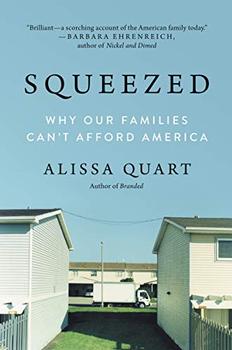Summary | Excerpt | Reading Guide | Reviews | Beyond the Book | Readalikes | Genres & Themes | Author Bio

Why Our Families Can't Afford America
by Alissa Quart
For the American middle class now, these markers of middle-class life are less and less common. The middle class is endangered on all sides, and the promised rewards of belonging to it have all but evaporated. This decline has also led to a degradation of self-image. Before the 2008 crash, only one-quarter of Americans viewed themselves as lowerclass or lower-middle-class. Even those who were struggling tended to view their problems as temporary. No longer. After the recession of 2008—which, though caused by the financial crash, could actually be said to have exposed or congealed decades of social class separation and downward mobility, since the Reagan era—a full 40 percent of Americans viewed themselves as being at the bottom of the pyramid. For the first time since pollsters had asked this question, fewer than half of those interviewed said that they were middle-class— only 44 percent, according to a Pew study. Meanwhile, the wealthy—with "wealth" here defined as assets minus debt— stand in stark relief to the Middle Precariat. A 2014 Russell Sage Foundation report puts the net worth of the top 5 percent at $1.3 million. The incomes of the top 1 to 5 percent have grown explosively in the past three decades, while the incomes of so many others have stagnated.
For the median family of color, that wage and wealth stagnation can be pretty dire. In a study published in 2017 by the organizations the Institute for Policy Studies and Prosperity Now (full disclosure; IPS is the fiscal sponsor of my organization, the Economic Hardship Reporting Project), the median wealth—assets minus debt—of white households is now over sixty-eight times higher than that of black households. For black families, the median was just $1,700.
The 2017 tax bill will likely only make these numbers even worse for many Americans. But this so-called tax reform is only the most recent example of how income inequality is written into the law of the land.
If you are an American working parent dealing with all of these stresses, you may feel like you are betting against the house and the house is always winning. Yet most of the parents I spoke to blamed only themselves, not a system stacked against them.
In Squeezed, you will meet a professor on food stamps in Chicago, an unemployed restaurant manager in Boston, and a nanny in New York City betrayed by the American Dream, and you will even hear about pharmacists who lost their jobs to a robot in Pittsburgh. They are people on the brink who did everything "right," and yet the math of their family lives is simply not adding up. Some are just getting by. For others, something happened and they tumbled down and never got back up.
For mothers in particular, this situation can be something I call the "class ceiling," the intersection of the "glass ceiling" that stymies workingwomen's careers and the result of the myriad injuries of social class.
This book hopefully illuminates the lives of the struggling middle class and offers strategies that may help. As these families struggle to preserve, or even simply to attain, a middle-class life, they do so in spite of, not because of, today's America. Here are their stories.
Excerpt from Squeezed: Why Our Families Can't Afford America by Alissa Quart. Copyright 2018 by Alissa Quart. Excerpted by permission of Ecco, an imprint of HarperCollins Publishers.
Never read a book through merely because you have begun it
Click Here to find out who said this, as well as discovering other famous literary quotes!
Your guide toexceptional books
BookBrowse seeks out and recommends the best in contemporary fiction and nonfiction—books that not only engage and entertain but also deepen our understanding of ourselves and the world around us.